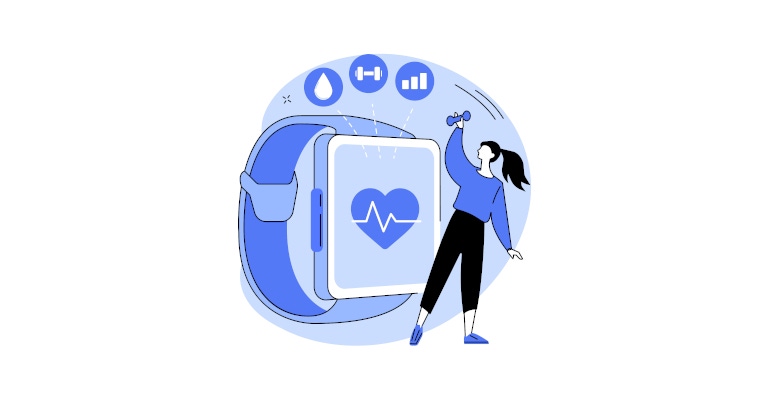Health Wearables and Their Role in Healthcare
Can engineers address design challenges and help bring health wearables to market?

The wearable technology market has been thriving during the pandemic. Grand View Research predicts its steady growth between 2021 and 2028. The market revenue is estimated to reach $118 billion by the end of the forecast period at a CAGR of 13.8%.
The demand from healthcare has accelerated the adoption of health wearables. Although the magnitude of the health crisis has diminished in 2022, COVID-19 and the possibility of new viruses still exist. The development of measures, including innovative health wearables, is required to address the threat. Are medical device software developers ready to address new challenges?
Health Wearables: An Overview
Health wearables comprise a set of devices and software solutions for remote patient monitoring, self-monitoring, and therapies. How do they work in practice?
Wearables for Remote Patient Monitoring
One of the implementations of the Internet of Medical Things (IoMT), remote patient monitoring (RPM), helps provide quality care at a distance and intervene timely to avoid health crises. As a rule, RPM tools are helpful for patients with chronic conditions, the elderly, and those recently discharged from a hospital. In the latter case, monitoring a patient’s vitals may help prevent relapses and harmful health incidents. But how do they work?
A device for remote patient monitoring measures vitals, stores the measured data, and transmits it to the authorized provider. These devices can also send specific emergency alerts to providers, caregivers, and family members when the measured parameter hits the highest or lowest limit. These tools help patients obtain quality care at home, eliminate manual data collection and entry, and allow clinicians to focus on readings to get more insights into a patient’s health and the likelihood of a complication.
Along with telehealth solutions, RPM tools proved efficient amidst the acute phase of the COVID-19 pandemic. RPM software was offered to patients experiencing coronavirus symptoms at M Health Fairview, a healthcare network from Minnesota. The software became part of their COVID-19 crisis resolution program that provided patients with educational materials and the opportunity to discuss their symptoms and concerns with a doctor without exposure for both parties. This RPM tool proved helpful for managing the infection at home, and about 75% of patients stated they would recommend their doctors to their relatives and friends.
Clinicians say COVID-19 recovery may be a rollercoaster with some symptoms coming and going. Patients can hardly be sure whether the symptoms signal a relapse or a temporary ailment on their own. For this matter, connected RPM tools are an efficient assistant allowing patients to interact with healthcare professionals to clear their doubts or seek another treatment.
What’s more, RPM tools can be an efficient patient engagement technology. By using RPM devices and interacting with clinicians, patients learn how to manage their health. It may induce patient engagement and power the transition from reactive to preventive healthcare.
Moreover, wearables are an essential part of such an industrywide process as digital transformation. Their adoption allows patients to obtain due care right wherever they are via a preferred means of communication.
Self-Monitoring mHealth Solutions
Mobile health (mHealth) apps help users collect data from sensors via a preferred mobile device (a smartphone or tablet), monitor it, and track trends. With mHealth apps, users manage self-care without clinician assistance. They only connect with providers if they detect some unclear or disturbing trends.
These apps can bring benefits to healthcare providers. First, users learn to manage their health independently. They are more likely to become engaged patients. Second, mHealth app functionality can be extended into a remote monitoring tool.
Although the number of sensors a smartphone or tablet has is limited, it may be enough for some conditions. According to researchers from the Queensland University of Technology (Brisbane, Australia), mobile health apps can monitor anxiety, neurological conditions, respiratory, and dermatological disorders.
mHealth apps also found their use during the pandemic. In 2020, Harvard University experts looked into the potential use of mHealth apps to mitigate the effects of the coronavirus pandemic. The experts found that it was possible to use the tools to monitor self-isolating patients with mild symptoms at home and address health deterioration timely. Moreover, combining an app with self-reporting capabilities and an app that measures and records health parameters can help clinicians predict disease outbreaks and start preparations in advance.
Health Wearables in Therapy
Monitoring is not the only thing health wearables can do. They may be a part of therapy for stroke recovery, mental conditions, and some chronic diseases, including multiple sclerosis and rheumatoid arthritis.
Stroke rehabilitation is difficult, and health wearables can help support it. For example, the RAPAEL rehab platform by Neofect helps restore hand movements after a stroke. It is a smart glove that helps visualize hand movements via connected sensors. The glove offers over 40 gamified exercises allowing patients to perform day-to-day activities (such as cutting bread).
Virtual reality wearables can also be a part of mental condition treatment. In 2019, researchers from the Medical University of South Carolina (Charleston, US) introduced a VR-powered wearable device that allows patients to share their PTSD experiences with their clinicians. The device captures images and monitors heart rate and sweat gland activity. Integrated with a smartphone, it allows patients to talk to their doctors and have their company when evoking a traumatic experience.
Challenges of Building Health Wearables
Despite the growing number of health wearables and increased adoption rates, medical device manufacturers face some hurdles, such as:
Sensitive data security
Efficient tool performance
Solving those challenges requires well-designed development and testing efforts as well as compliance with regulatory frameworks.
As a rule, security testing comprises vulnerability assessment and penetration testing. To assess wearable software security, the experts examine the specification and define the potential weak spots. Such vulnerabilities can be used by malicious actors, who steal health data and other personal information.
This hazard justifies the need for another testing effort—penetration testing. Within this phase, qualified engineers try to break into the app to mock the data theft. They create an exhaustive report of the security loopholes and patch recommendations.
As for performance testing of wearables, it involves load testing that helps adjust the server infrastructure to users’ needs. Other performance testing types—stress, volume, scalability, and stability testing—employ test scenarios that imitate users’ actions. It’s also wise to run performance monitoring to assess the continuous hardware operation.
With all those bases covered, the team is likely to launch a quality IoMT app and health wearable device into the market.
Final Note
Health wearables can become powerful assistants to doctors and patients as they enhance self-management and care provision. They are valuable data sources that provide insights into each patient’s health trends and allow doctors to personalize treatments and management strategies.
Besides, wearables help ensure uninterrupted care delivery in turbulent times like the coronavirus pandemic. The data collected with wearables allow providers to reduce care delivery costs and improve inventory management, replacing unnecessary hospitalizations with quality at-home care.
About the Author(s)
You May Also Like





